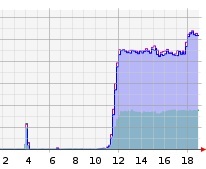A Monifieth teenager has become an instant online star after creating a programme that took Twitter by storm.
Seventeen year-old James Cunningham’s Twifficiency app rates users’ efficiency by analysing stats including how many messages they post and how many followers they have.
Although he only developed the programme as an experiment, anyone who used it found their results were posted on their own Twitter page along with a link to the Twifficiency app itself.
This meant the programme went viral within the space of 24 hours and the Twifficiency homepage went from having just a few visits to more than half a million in the space of two hours.
The teenage programmer, who tweets at @jamescun, woke up on Wednesday morning to find that he had thousands of messages from users and that Twifficiency has become one of the most searched for terms on Google.
“It wasn’t really meant to be used as a programme, it was just me creating something to see how to use a programme,” the former Monifieth High School pupil told The Courier.
“It was online for a little while and nothing much happened but it went from no views to 500,000 in a couple of hours.”
Stephen Fry is just one of the thousands who have used the programme, while its success has also caught the eye of Facebook creator Mark Zuckerberg, who is now following James’ own Twitter account.
However, not every user was pleased that the programme automatically posted its results to Twitter and some accused James of creating it to steal personal information at a later date.
“People seemed quite angry that it had Tweeted their results but that was just an oversight,” said James, who has now added a box to the Twifficiency page allowing users to stop their results being posted online.
“I put up a message about it a lot of people seem upset just because they didn’t read it,” he said.
Despite a hostile reaction from some parts of the internet, that hasn’t dampened the self-confessed “coder, gamer and wannabe-entrepreneur’s” enthusiasm.
He begins an HND in computer networking and internet technology at Dundee College later this month and intends to go on to university afterwards.
“It’s not put me off at all if anything it has encouraged me to create more,” he said.
James’ father Angus said he was not surprised that his son has created such a highly successful programme.
“We’ve always known he’s got something he’s a smart kid,” he said.
